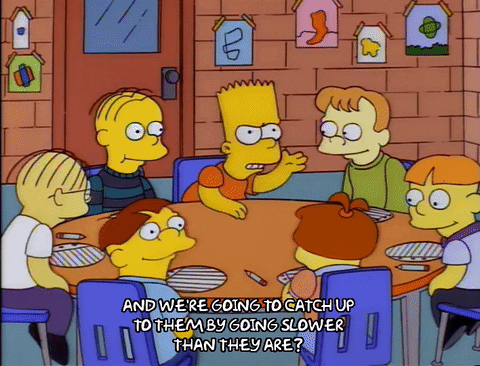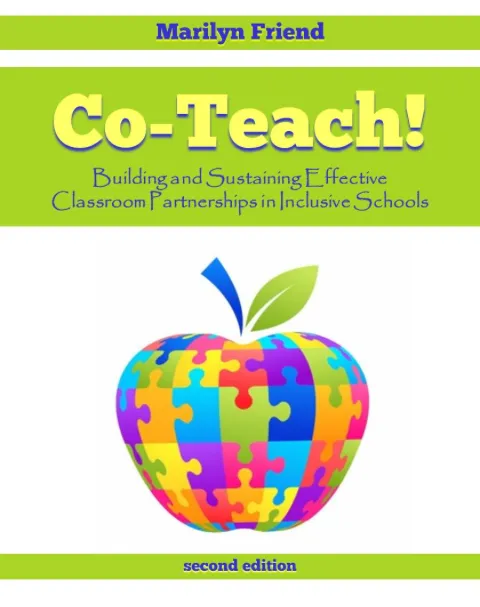Most of you know me as a weird geek who is obsessed with Star Wars, looking for life lessons in pop culture, taking his kids to movies and making fun of himself (or you don't know me at all and you are like, "Who is this goof?").
But I am also a high school special education teacher.

Actually I'd prefer if this said "all people".
Earlier this summer, I was lucky enough to attend an educational workshop run by one of my personal heroes, Dr. Marilyn Friend.
Dr. Friend is the Chairperson and Professor of Education in the Department of Specialized Education Services at the University of North Carolina at Greensboro. She is also currently serving on the Board of the Teacher Education Division of the Council for Exceptional Children, an organization dedicated to advocating for the rights of and best teaching practices for students with disabilities. Before serving on the board, Dr. Friend was the President of the C.E.C. She is an educational consultant who has conducted more than 1000 workshops in the United States, Canada, Europe, and Asia.
Although that is all quite impressive, I know her as the godmother of co-teaching.
According to Dr. Friend, co-teaching is an educational delivery model which "offers options to enable students with disabilities to reach their potential by providing them with access to the general education curriculum while ensuring they receive the specially designed instruction to which they are entitled." The model involves two or more educators with equivalent licensure working side by side and sharing responsibility for the education of all students in a classroom.
According to me, co-teaching is a way to ensure that all students have an opportunity to benefit from an excellent education. It is a way to help every student to help themselves reach their full potential. It is a way for a school and community to demonstrate that it values and believes that all students can succeed. Co-teaching is what I would want my child to have access to if he or she had a disability.

Two heads are better than one!
This model allows for students with disabilities to be educated along side their peers without disabilities instead of being isolated from them in a separate setting with a different teacher. Not only does this model fulfill the spirit of the special education laws in the United States which dictate that a student should be educated in the "least restrictive environment", it also provides students with disabilities equal access to the social and educational benefits their peers receive.
Although there are some exceptions involving students whose needs are so intense that they would not be able to be met in a heterogeneous environment, for the majority of students with disabilities, co-teaching levels the playing field for them.
This is extremely important considering the vast majority of students with special needs have average to above average intelligence. For example, a student may have a disability which interferes with her ability to write a written argument, but she can dominate any verbal debate. She can also learn skills that will help her to improve her written expression.
This leveling of the field is the true goal and benefit of co-teaching. The idea is not to require the students to do less, it is to use more and different techniques to ensure that the students can access the same curriculum as their peers. By having two educators in the classroom, these "more and different" interventions can be effectively implemented.

No Bart. We are going to catch up by using more and different techniques that match your needs.
Co-teaching is a way to make sure that all students arrive at the same destination... even if they have to take different roads to get there.
Once in the classroom, co-teaching can take many shapes. This flexibility is one of the most beautiful things about co-teaching. The approach can change in order to meet students' individual needs on any given day.
The following are five possible co-teaching approaches. I have listed them in the order of how frequently I believe each should be used in a high school co-taught classroom.

This diagram is not numbered in order of frequency. My list below is.
1. Station teaching.
This is my favorite approach. It involves the two teachers dividing students and content. Each teacher teaches a specific part of the lesson. Usually this approach involves three stations. Two of the stations are teacher lead while the third is independent.
2. Alternative teaching.
This approach along with parallel teaching are tied for my second favorite approaches. In this approach, one teacher teaches to a larger group while the seance teacher provides specialized instruction to a smaller group. This allows the second teacher to teach things differently and provide more support to the smaller group. I especially like this approach because in this one, the smaller group could be students with special needs or it could be a group of more advanced students who were able to move faster and deeper into the lesson or topic. Either teacher could provide this supplemental material/instruction.
3. Parallel teaching.
In some cases, student learning could be enhanced merely by learning in a smaller group which would allow more direct instructor contact with each student. Parallel teaching provides this opportunity by splitting the class into two equal ha;ver with each teacher facilitating the same lesson. In this case, both groups could be completely heterogeneous. Either teacher could teach either group.
4. Teaming.
In this approach both teachers deliver the same instruction at the same time. This approach can be very effective if it has a specific intended purpose. For example, if teachers were instructing students on prefixes and suffixes, one teacher could wear prefixes on the front of their shirt while the other wore suffixes on their back. Each teacher could facilitate part of the lesson. However if this merely turned into one teacher repeating or rephrasing the other teacher, then this is very inefficient. In effect, there are two people who are doing the job of one teacher. Although this method typically does not meet the test of providing "more and different" instruction, it can be effective in certain situations.
5. One teach, one assist.
This method looks more like a lead teacher being assisted by a teacher aide or para-educator. The lead teacher would facilitate a lesson while the other teacher circulated through the room providing one on one assistance "on the fly". Although the stay be effective fro some material, if it is overused, it can become very distracting not only for the student receiving the intervention but also for the surrounding students. This also creates a situation where both teachers do not appear to be equal partners in the classroom. If this approach is used, it may be necessary to alternate the roles between the two teachers.
6. One teach, one observe.
This approach would only be used if the team needed to collect data on one or several students. This could be very beneficial if a student has a specific plan to address his or her behaviors. It could also help in writing data based goals for a student's individualized education plan. Although this model definitely has value, it should not be the dominant approach in a co-taught classroom.

In my next education related piece, I will delve deeper into my favorite approach: station teaching.
But before then, I'll probably write something a little lighter. Maybe I'll just ask my wife to tell me something stupid that I have done recently and I'll write about that...
Yep. She said she already has a list.
For those of you interested in supporting educational posts on steemit, please check out @steemiteductaion. @steemiteducation resteems at least 10 high quality education related posts each day. If you go to the blog, you can see the daily selections.
If you don't know what @steemiteducation is all about, please check out the following video.
For more information about co-teaching, please visit http://www.marilynfriend.com.